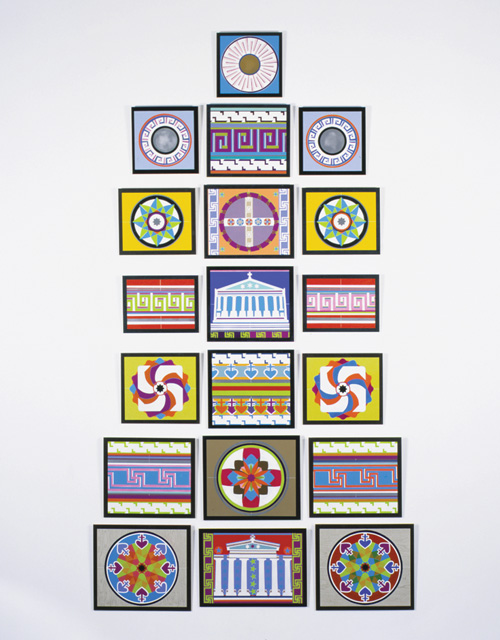


Decoration is a cursed word. It implies a vacuum of content in which only the surface exists and pretty colouration brightens a barren space. But where does the line between art and decoration cross? And at what point do patterns, mouldings and coloured surfaces move on beyond 'mere' decoration and take on a sense of the profound?
If decoration is an issue, so is that of multiculturalism in the potpourri society of Australia. Should a resident born on the other side of the world accept football and meat pies as their new culture? And then there is politics. What relevance does a contemporary visual artist have in the world of social and political issues?
Tackling all of the above, and rendered in cheap, throwaway materials, the work of Constanze Zikos is an oddity in contemporary visual arts discourse. Not afraid to be decorative, his work simultaneously takes on the aesthetic of kitsch.
Born in Greece, Zikos found his calling early in his career in the deconstruction of the cheaper elements of contemporary Greek suburban culture. Simultaneously, his kitsch colouration was leading geometric abstraction in new directions. By painting in enamel with raw primary colours on a surface of Laminex, Zikos was breaking rules and finding new ways to express his, and his culture's, place in the Australian vernacular.
Australia is a uniquely successful multicultural society and this melting pot of races and cultures has naturally informed contemporary Australian art. Artists from such disparate backgrounds as Imants Tillers, Lindy Lee and Juan Davila have all made much of their particular cultural roots as important strategic tools within their work. Despite the fact that Zikos's family relocated to Australia in 1966, when Zikos was four, his national origins have strongly informed his work.
Zikos's works are indicative of the exploration of his past within the context of both his adopted culture and contemporary thought and art practice. Heavenly myth (1991) utilises the media of Laminex, a substance more akin to 1970s Australian kitchens and kitsch than iconic Greek design; however, in a strange blend, Zikos manages to fuse the two influences. While one might imagine this to be the direct result of a Grecian influence, this group of paintings confound any cliché of quotation. Zikos's pop style colouration would, at least on first impression, seem to be the antithesis of Grecian classicism. However, an often forgotten fact about Greek classical design is its use of colour; the columns on classical Greek architecture were carefully, and quite brightly, coloured—an element that age has faded and erased. As Robyn McKenzie notes, 'Zikos' unconventional materials (Laminex and the spraycan), his use of high key "designer" colours, and pattern, can be viewed as a critical dismantling of the transcendent purity of modernist abstraction.' But, she suggests, Zikos doesn't simply react against abstraction; instead, he relocates 'the classical in the contemporary design styles of a popular Greek-Australian cultural identity—a touristic or souvenir aesthetic, a relocation itself, of Greece to Australia'.1
Zikos's classical Greek emblems are often inscribed across Laminex surfaces. By depicting flags and geometric patterns, Zikos has engaged with how cultural motifs can be utilised and transformed. The kitsch and homely quality of Laminex is contrasted with the symbolic forms that question aspects of cultural identity. As McKenzie suggests: 'In his manipulation of geometric order Zikos locates a point where different worlds lock gear: pattern and abstraction, decorative design and avant garde aesthetics, high art and kitsch, Greece and Australia, ancient and modern'. 2
There is also a playfulness at work here. Zikos is highly aware of the seriousness of classical Greek art and its cultural significance. To utilise such material via the suburban material of Laminex is a perfectly Australian twist—both an acknowledgment of his cultural past and a larrikin play upon its contemporary significance. According to Max Delany: 'Constanze Zikos also plays with the conventions of memory and the semantics of architectural embellishment and abstraction. If the unifying emblems of modernity, identity and nationhood provide the ostensible subject, Zikos' project is one of alteration and renovation.'
- Ashley Crawford
Constanze Zikos is represented in Australia by Murray White Room, Melbourne.